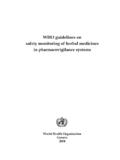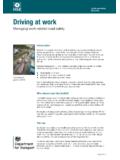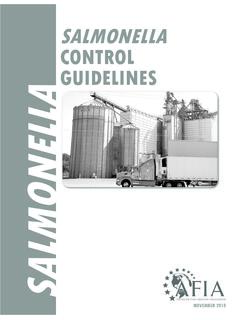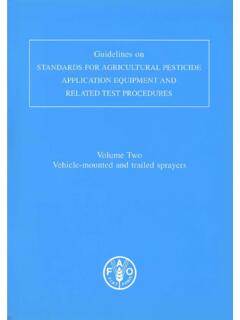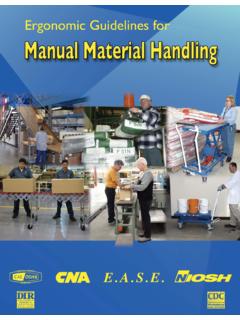Transcription of Management Leadership Worker Participation Find and Fix ...
1 Recommended Practices for safety and health ProgramsWorker ParticipationFind and Fix HazardsManagement LeadershipOccupational safety and health OSHA 3885 October 2016 DISCLAIMERT hese practices for safety and health programs are recommendations only. Employers are not required to have a safety and health program that complies with them and will not be cited for failing to have a safety and health program that complies with this recommended practices apply to employers, except in the construction industry, for whom there are separate Recommended Practices for safety and health Programs for the Construction a safety and health program in your workplace is one of the most effective ways of protecting your most valuable asset: your workers. Losing workers to injury or illness, even for a short time, can cause significant disruption and cost to you as well as the workers and their families. It can also damage workplace morale, productivity, turnover, and and health programs foster a proactive approach to finding and fixing workplace hazards before they can cause injury or illness.
2 Rather than reacting to an incident, Management and workers collaborate to identify and solve issues before they occur. This collaboration builds trust, enhances communication, and often leads to other business improvements. Employers who have implemented safety and health programs, including many who are in OSHA s Voluntary Protection Programs (VPP) or the safety and health Achievement Recognition Program (SHARP) for small and medium-sized businesses, have also found that managing for safety results in higher-quality product or output and higher of responsible employers have used OSHA s 1989 safety and health Program Management Guidelines as a blueprint for setting up an effective safety and health has changed, however, since those guidelines were published: The nature of work is evolving as the economy continues to shift from a manufacturing to a service base, and from a fixed to an often mobile and Tools to Support Implementation of These Recommended PracticesOSHA has created a dedicated Web page to support the implementation of these recommended practices at The page includes the following.
3 Additional resources. Articles and information sources related to each core element of the recommended practices, plus other topics discussed in the recommended practices. Tools. Downloadable templates, worksheets, and reference materials you can use as you develop your own safety and health program. Please visit the recommended practices Web page and explore the resources available. OSHA will update the Web page and add resources and tools as they become available. Automation of work activities means that technology, computers, and robotics are being integrated into our workplaces, often introducing new and different hazards . Greater diversity in the workplace means that people from different backgrounds and cultures are working alongside each other, often speaking different languages. 1 54 FR 3904 16, January 26, PRACTICES FOR safety AND health PROGRAMSFOREWORD An aging workforce and the rise of sedentarywork and lifestyle means that someworkers are at higher risk for work-relatedmusculoskeletal disorders.
4 There is greater recognition that workersin industries that some think of as safe(such as healthcare, lodging, retail, andtransportation) face significant hazards . Increased temporary and contractemployment, and the rise of the gigeconomy mean that traditional relationshipsbetween workers and employers are shifting,and changes in safety programs and policieswill be required to ensure the safety of allworkers at worksites characterized by thesenewer and more fluid new recommended practices reflect these changes. They also reflect what we have learned from best-in-class programs and what makes them effective. In particular, these recommended practices place greater emphasis on involving workers, and include a more robust program evaluation element to help drive continuous improvement. The recommended practices also stress the need for communication and coordination on worksites involving more than one addition, the new recommended practices build on successful approaches and practices that have evolved under OSHA programs such VPP and SHARP.
5 They also align with national and international consensus A comparison of these recommended practices, the 1989 guidelines, OSHA voluntary programs, and other consensus standards is available on the Recommended Practices for safety and health Programs PRACTICES FOR safety AND health ..2 Management Leadership ..9 Worker Participation ..11 HAZARD IDENTIFICATION AND PREVENTION AND CONTROL ..20 EDUCATION AND TRAINING ..24 PROGRAM EVALUATION AND IMPROVEMENT ..27 COMMUNICATION AND COORDINATION FOR HOST EMPLOYERS, CONTRACTORS, AND STAFFING AGENCIES ..30 LIST OF ABBREVIATIONS ..34 GLOSSARY OF TERMS .. PRACTICES FOR safety AND health PROGRAMSINTRODUCTIONTHESE RECOMMENDED PRACTICES provide responsible employers, workers, and Worker representatives3 with a sound, flexible framework for addressing safety and health issues in diverse workplaces. They may be used in any workplace, but will be particularly helpful in small and medium-sized workplaces.
6 They can be applied equally well in traditional, fixed manufacturing workplaces and in the service sector, healthcare, retail, and even mobile or office-based work environments. They also include information specifically aimed at temporary Worker and multiemployer work situations. Separate recommended practices are available for the construction Worker Participation is vital to the success of the program. In several places in this document, OSHA refers not just to workers but also to their representatives, such as labor unions or religious or community : Ohio Bureau of Workers Compensation (2011), Ohio 21(d) SHARP Program Performance recommended practices emphasize a proactive approach to managing workplace safety and health . Traditional approaches are often reactive that is, actions are taken only after a Worker is injured or becomes sick, a new standard or regulation is published, or an outside inspection finds a problem that must be corrected.
7 Finding and fixing hazards before they cause injury or illness is a far more effective approach. Doing so avoids the direct and indirect costs of Worker injuries and illnesses, and promotes a positive work concept of continuous improvement is central to the recommended practices. As with any journey, the first step is often the most challenging. The idea is to begin with a basic program and grow from there. By initially focusing on achieving modest goals, monitoring performance, and evaluating outcomes, you can help your workplace progress, over time, along the path to higher levels of safety and health . THE BENEFITS OF IMPLEMENTING THESE RECOMMENDED PRACTICESR esponsible employers know that the main goal of a safety and health program is to prevent workplace injuries, illnesses, and deaths, as well as the suffering and financial hardship these events can cause for workers, their families, and their employers.
8 Employers may find that implementing these recommended practices brings other benefits as well. The renewed or enhanced commitment to safety and health and the cooperative atmosphere between employers and workers have been linked to: Improvements in product, process, and service quality. Better workplace morale. Improved employee recruiting and retention. A more favorable image and reputation (among customers, suppliers, and the community). (per million dollars of payroll)A study of small employers in Ohio found that workers compensation claims fell dramatically after working with OSHA s SHARP program to adopt programs similar to those described in these recommended of claimscost per claimclaims52%+DECREASEDDECREASED80%88%D ECREASED average lost time per claim87% PRACTICES FOR safety AND health PROGRAMSHOW TO USE THE RECOMMENDED PRACTICESEach section of the recommended practices describes a core program element (see page 7), followed by several action items.
9 Each action item is an example of steps that employers and workers can take to establish, implement, maintain, and improve your safety and health program. You can use the self-evaluation tool found on the recommended practices Web page to track your progress and assess how fully you have implemented (or will implement) each action interrelated elementsThe seven core elements are interrelated and are best viewed as part of an integrated system. Actions taken under one core element can (and likely will) affect actions needed under one or more other elements. For example, workers must be trained in reporting procedures and hazard identification techniques in order to be effective Source: Leigh, (2011), Economic Burden of occupational Injury and Illness in the United States. Milbank Quarterly, 89 The multiplier for indirect costs includes some social costs, such as workers compensation costs not covered by safety & health programcan help employers avoid the that resultfrom due to work stoppages andinvestigations, training and other costs associated with to material, machinery and property.
10 Andsuch as TIMELOST REPLACING INJURED WORKERS LOSS ORDAMAGE INDIRECTCOSTST hese have been estimatedto be at least times theINDIRECTCOSTSDIRECTCOSTSWORKPLACEINCI DENTS4 RECOMMENDED PRACTICES FOR safety AND health EASY THINGS TO GET YOUR PROGRAM STARTEDIf these recommended practices appear challenging, here are some simple steps you can take to get started. Completing these steps will give you a solid base from which to take on some of the more structured actions presented in the recommended SET safety AND health AS A TOP PRIORITYA lways set safety and health as the top priority. Tell your workers that making sure they finish the day and go home safely is the way you do business. Assure them that you will work with them to find and fix any hazards that could injure them or make them LEAD BY EXAMPLEP ractice safe behaviors yourself and make safety part of your daily conversations with IMPLEMENT A REPORTING SYSTEMD evelop and communicate a simple procedure for workers to report any injuries, illnesses, incidents (including near misses/close calls), hazards , or safety and health concerns without fear of retaliation.











